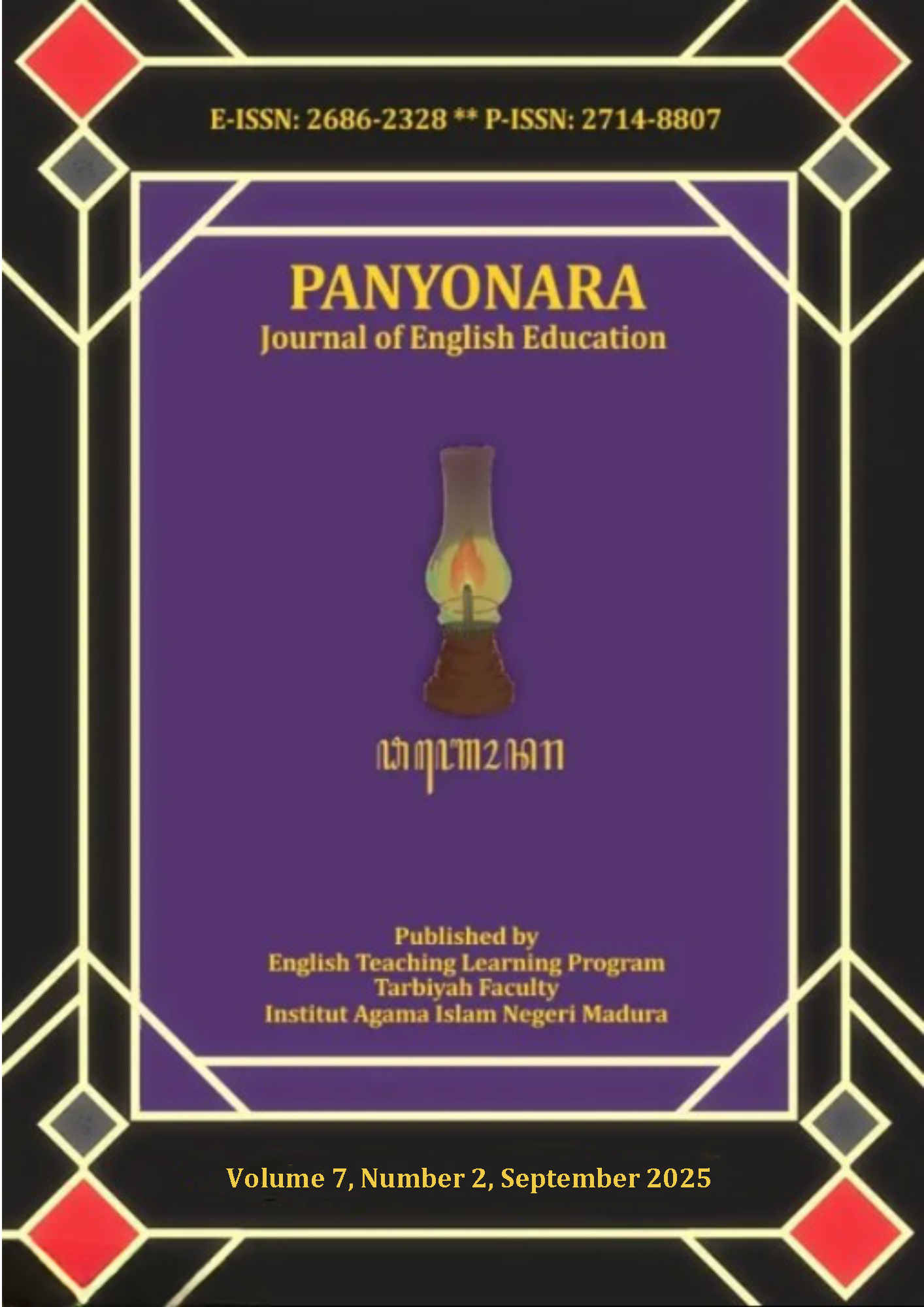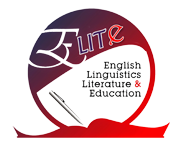Perceptions and Experiences of Flipped Learning in English Language Teaching Departments in Indonesia
-
 Abstract views: 211
,
Abstract views: 211
,
 PDF downloads: 73
PDF downloads: 73
Abstract
This paper aims to explore the perceptions and experiences of flipped learning in English teaching classes in Indonesian universities. Firstly, it explores the implementation of flipped learning worldwide in the context of English teaching. Afterwards, interviews will be conducted with the heads of departments with at least one lecturer implementing flipped learning and students who are taught using flipped learning in their English classes. From the literary works, it is found that flipped learning’s benefits are in line with the need to improve Indonesian English Language Teaching. Regarding the drawbacks, flipped learning is not against the regulations of higher education institutions. Instead, it enforces the policies decreed in the university context. According to the heads of the departments, flipped learning will be more widely accepted in the future. However, there is one big concern regarding resources, particularly in remote areas. The students report better learning experiences, but also complain about study load, time limitations, IT issues, language barriers, and distractions. In addition, the student-participants also suggest being facilitated with more feedback and interactive yet meaningful activities in class.
Downloads
References
Aghaei, K., Rajabi, M., Lie, K. Y., & Ajam, F. (2020). Flipped learning as situated practice: A contrastive narrative inquiry in an EFL classroom. Education and information technologies, 25(3), 1607-1623. doi:10.1007/s10639-019-10039-9
Akçayır, G., & Akçayır, M. (2018). The flipped classroom: A review of its advantages and challenges. Computers & Education, 126, 334-345. doi:10.1016/j.compedu.2018.07.021
Amiryousefi, M. (2019). The incorporation of flipped learning into conventional classes to enhance EFL learners' L2 speaking, L2 listening, and engagement. Innovation in Language Learning and Teaching, 13(2), 147-161. doi:10.1080/17501229.2017.1394307
Aprianto, E., Purwati, O., & Anam, S. u. (2020). Multimedia-assisted learning in a flipped classroom: A case study of autonomous learning on EFL university students. International journal of emerging technologies in learning, 15(24), 114-127. doi:10.3991/ijet.v15i24.14017
Arsanti, L., Wijayanto, A., & Suparno. (2020). Exploring the students’ response of flipped learning through Social Networking Sites (SNSs). Indonesian Journal of EFL and Linguistics, 5(2). doi:http://dx.doi.org/10.21462/ijefl.v5i2.277
Arslan, A. (2020). A systematic review on flipped learning in teaching English as a foreign or second language. The journal of language and linguistic studies, 16(2), 775-797. doi:10.17263/jlls.759300
Atmanegara, Y., & Dianti, R. (2020). The implication of flipped learning model in tertiary critical reading class. English franca: Academic journal of English language and education, 4(2). doi:http://dx.doi.org/10.29240/ef.v4i2.1793
Bergmann, J., & Sams, A. (2012). Flip your classroom reach every student in every class every day. United States of America: International society for technology in education.
Bicen, H., & Beheshti, M. (2022). Assessing perceptions and evaluating achievements of ESL students with the usage of infographics in a flipped classroom learning environment. Interactive Learning Environments, 30(3), 498-526. doi:10.1080/10494820.2019.1666285
Braun, V., & Clarke, V. (2006). Using thematic analysis in psychology. Qualitative Research in Psychology, 3(2), 77-101. doi:10.1191/1478088706qp063oa
Challob, A. I. (2021). The effect of flipped learning on EFL students’ writing performance, autonomy, and motivation. Education and information technologies, 26(4), 3743-3769. doi:10.1007/s10639-021-10434-1
Chen, K. S., Monrouxe, L., Lu, Y. H., Jenq, C. C., Chang, Y. J., Chang, Y. C., & Chai, P. Y. C. (2018). Academic outcomes of flipped classroom learning: a meta‐analysis. Medical Education, 52(9), 910-924. doi:10.1111/medu.13616
Chiang, F.-K., & Wu, Z. (2021). Flipping a classroom with a three-stage collaborative instructional model (3-CI) for graduate students. Australasian Journal of Educational Technology, 37(4), 51-67. doi:10.14742/ajet.6330
Chowdhury, F. (2020). Blended learning: how to flip the classroom at HEIs in Bangladesh? Journal of Research in Innovative Teaching & Learning, 13(2), 228-242. doi:10.1108/JRIT-12-2018-0030
Chuang, H. H., Weng, C. Y., & Chen, C. H. (2018). Which students benefit most from a flipped classroom approach to language learning? British Journal of Educational Technology, 49(1), 56-68. doi:10.1111/bjet.12530
Directorate General of Higher Education. (2014). Buku kurikulum pendidikan tinggi [Curriculum handbook of higher education]. In. Jakarta: Ministry of Education and Culture of Republic of Indonesia.
Doman, E., & Webb, M. (2017). The Flipped experience for Chinese university students studying English as a foreign language. TESOL Journal, 8(1), 102-141. doi:10.1002/tesj.264
Elmaadaway, M. A. N. (2018). The effects of a flipped classroom approach on class engagement and skill performance in a Blackboard course. British Journal of Educational Technology, 49(3), 479-491. doi:10.1111/bjet.12553
Eryilmaz, M., & Cigdemoglu, C. (2019). Individual flipped learning and cooperative flipped learning: Their effects on students’ performance, social, and computer anxiety. Interactive Learning Environments, 27(4), 432-442. doi:10.1080/10494820.2018.1522652
Fauzan, A., & Ngabut, M. N. (2018). EFL students’ perception on flipped learning in writing class. Journal on English as a Foreign Language, 8(2), 115-129. doi:10.23971/jefl.v8i2.792
Galindo-Dominguez, H. (2021). Flipped Classroom in the Educational System
Trend or Effective Pedagogical Model Compared to Other Methodologies? Educational Technology & Society, 24(3), 44-60. Retrieved from https://www.jstor.org/stable/27032855
Griffith, A. (2017). The Feasibility of Flipping: An Exploratory Analysis of the Flipped Classroom in a Developing Country. The Journal of Effective Teaching, 17, 72-89.
Kashada, A., Li, H., & Su, C. (2017). Adoption of Flipped Classrooms in K-12 Education in Developing Countries: Challenges and Obstacles. International Journal of Emerging Technologies in Learning (iJET), 12(10), pp. 147-157. doi:10.3991/ijet.v12i10.7308
Kemenristekdikti Republik Indonesia. (2015). National standard for higher education. In (Vol. 44). Jakarta: Kemenristekdikti Republik Indonesia,.
Kemenristekdikti Republik Indonesia. (2016). Panduan penyusunan kurikulum pendidikan tinggi [Guideline for higher education curriculum]. In. Jakarta: Kemenristekdikti Republik Indonesia.
Ketut Putri Handayani, D., Santosa, M., & Nyoman Pasek Hadi Saputra, I. (2018). Secondary school teachers’ perception towards the use of flipped learning in Buleleng regency. JPBI (Journal of English Language Teaching), 4.
Khan, M. S. H., & Abdou, B. O. (2021). Flipped classroom: How higher education institutions (HEIs) of Bangladesh could move forward during COVID-19 pandemic. Social Sciences & Humanities Open, 4(1), 100187. doi:https://doi.org/10.1016/j.ssaho.2021.100187
Lee, G.-G., Jeon, Y.-E., & Hong, H.-G. (2021). The effects of cooperative flipped learning on science achievement and motivation in high school students. International Journal of Science Education, 43(9), 1381-1407. doi:10.1080/09500693.2021.1917788
Lee, G., & Wallace, A. (2018). Flipped learning in the English as a foreign language classroom: Outcomes and perceptions. TESOL Quarterly, 52(1), 62-84. doi:10.1002/tesq.372
Lestari, I. W. (2021). Flipped classroom in indonesian higher education: A mixed-method study on students’ attitudes and experiences. Studies in English language and education, 8(1), 243-257. doi:10.24815/siele.v8i1.17636
Li, Z., & Li, J. (2022). Using the Flipped Classroom to Promote Learner Engagement for the Sustainable Development of Language Skills: A Mixed-Methods Study. Sustainability, 14(10), 5983. Retrieved from https://www.mdpi.com/2071-1050/14/10/5983
Lijun, D. (2020). The Process-oriented Assessment Model of Business English Translation Course in a Flipped Learning Context. Higher Education Studies, 10, 1-1. doi:10.5539/hes.v10n4p1
Liu, C., Sands-Meyer, S., & Audran, J. (2018). The effectiveness of the student response system (SRS) in English grammar learning in a flipped English as a foreign language (EFL) class. Interactive Learning Environments, 1-14. doi:10.1080/10494820.2018.1528283
Lubis, A. H., & Samsudin, D. (2021). Characteristics of an effective EFL teacher in Indonesia: Expectations and realities in a technology-enhanced flipped classroom. Indonesian Journal of English Language Teaching and Applied Linguistics, 5(2). doi:http://dx.doi.org/10.21093/ijeltal.v5i2.820
Mujtaba Asad, M., Athar Ali, R., Churi, P., & Moreno-Guerrero, A.-J. (2022). Impact of Flipped Classroom Approach on Students’ Learning in Post-Pandemic: A Survey Research on Public Sector Schools. Education Research International, 2022(1), 1134432. doi:https://doi.org/10.1155/2022/1134432
Nababan, P. W. J. (1991). Language in education: The case of Indonesia. International review of education = Internationale Zeitschrift für Erziehungswissenschaft = Revue internationale de pédagogie., 37(1), 115-131.
Öztürk, M., & Çakıroğlu, Ü. (2021). Flipped learning design in EFL classrooms: implementing self-regulated learning strategies to develop language skills. Smart learning environments, 8(1), 1-20. doi:10.1186/s40561-021-00146-x
Pallathadka, H., & Pallathadka, L. (2020). FLIPPED Classroom Approach: Opportunities and Challenges. 7, 2020.
Rad, H. S. (2021). Effect of PCaRD DGB flipped learning on EFL learners’ grammar skill. The Journal of AsiaTEFL, 18(2), 544-558. doi:10.18823/asiatefl.2021.18.2.10.544
Shahnama, M., Ghonsooly, B., & Shirvan, M. E. (2021). A meta-analysis of relative effectiveness of flipped learning in English as second/foreign language research. Educational Technology Research and Development, 69(3), 1355. doi:10.1007/s11423-021-09996-1
Shih, H.-c. J., & Huang, S.-h. C. (2020). EFL learners' metacognitive development in flipped learning: a comparative study. Interactive Learning Environments, 1-13. doi:10.1080/10494820.2020.1728343
Shin, S., Kwon, K., & Jung, J. (2022). Collaborative Learning in the Flipped University Classroom: Identifying Team Process Factors. Sustainability, 14(12), 7173. Retrieved from https://www.mdpi.com/2071-1050/14/12/7173
Singh, S., & Arya, A. (2020). A hybrid flipped-classroom approach for online teaching of biochemistry in developing countries during Covid-19 crisis. Biochemistry and Molecular Biology Education, 48(5), 502-503. doi:https://doi.org/10.1002/bmb.21418
Stracke, E. (2007). A road to understanding: A qualitative study into why learners drop out of a blended language learning (BLL) environment. ReCALL, 19(1), 57-78. doi:10.1017/S0958344007000511
Suwito, S., & Hamdani, A. F. (2019). Developing Students Learning Attributes Through Collaborative Learning Based on Flipped Classroom. Geosfera Indonesia, 4(1), 1-10. doi:10.19184/geosi.v4i1.8938
Turan, Z., & Akdag-Cimen, B. (2020). Flipped classroom in English language teaching: a systematic review. Computer assisted language learning, 33(5-6), 590-606. doi:10.1080/09588221.2019.1584117
Vuong, N. H. A., Tan, C. K., & Lee, K. W. (2018). Students' perceived challenges of attending a flipped EFL classroom in Viet Nam. Theory and Practice in Language Studies, 8(11), 1504-1510. doi:http://dx.doi.org/10.17507/tpls.0811.16
Wagner, M., & Urhahne, D. (2021). Disentangling the effects of flipped classroom instruction in EFL secondary education: When is it effective and for whom? Learning and instruction, 75. doi:10.1016/j.learninstruc.2021.101490
Wright, B. M. (2017). Blended learnings student perception of face-to-face and online EFL lessons. Indonesian Journal of Applied Linguistics, 7(1), 64. doi:10.17509/ijal.v7i1.6859
Wu, W.-C. V., Hsieh, J. S. C., & Yang, J. C. (2017). Creating an online learning community in a flipped classroom to enhance EFL learners’ oral proficiency. Educational Technology & Society, 20(2), 142-157.
Youhasan, P., Chen, Y., Lyndon, M., & Henning, M. A. (2021). Assess the feasibility of flipped classroom pedagogy in undergraduate nursing education in Sri Lanka: A mixed-methods study. PLoS ONE, 16(11), e0259003. doi:10.1371/journal.pone.0259003
Yulian, R. (2021). The flipped classroom: Improving critical thinking for critical reading of efl learners in higher education. Studies in English language and education, 8(2), 508-522. doi:10.24815/siele.v8i2.18366
Zainuddin, Z. (2017). First-year college students’ experiences in the EFL flipped classroom: A case study in Indonesia. International Journal of Instruction, 10(1), 133-150.
Zainuddin, Z., Habiburrahim, Muluk, S., & Muftia Keumala, C. (2019). How do students become self-directed learners in the EFL flipped-class pedagogy? A study in higher education. Indonesian Journal of Applied Linguistics, 8(3), 678-690.
Zainuddin, Z., & Halili, S. H. (2016). Flipped classroom research and trends from different fields of study. International Review of Research in Open and Distributed Learning, 17(3), 313-340. doi:10.19173/irrodl.v17i3.2274
Zainuddin, Z., & Perera, C. J. (2018). Supporting students’ self-directed learning in the flipped classroom through the LMS TES Blendspace. On the Horizon, 26(4), 281-290. doi:10.1108/OTH-04-2017-0016
Zaka, P., Fox, W. H., & Docherty, P. D. (2019). Student perspectives of independent and collaborative learning in a flipped foundational engineering course. Australasian Journal of Educational Technology, 35(5), 79-94. doi:10.14742/ajet.3804
The journal uses an Open Access policy under a Creative Commons Attribution-NonCommercial 4.0 International License. Authors who publish with this journal agree to the following terms:
- Authors retain copyright and grant the journal right of first publication with the work simultaneously licensed under a Creative Commons Attribution License that allows others to share the work with an acknowledgment of the work's authorship and initial publication in this journal.
- Authors are able to enter into separate, additional contractual arrangements for the non-exclusive distribution of the journal's published version of the work (e.g., post it to an institutional repository or publish it in a book), with an acknowledgment of its initial publication in this journal.
- Authors are permitted and encouraged to post their work online (e.g., in institutional repositories or on their website) prior to and during the submission process, as it can lead to productive exchanges, as well as earlier and greater citation of published work.
















